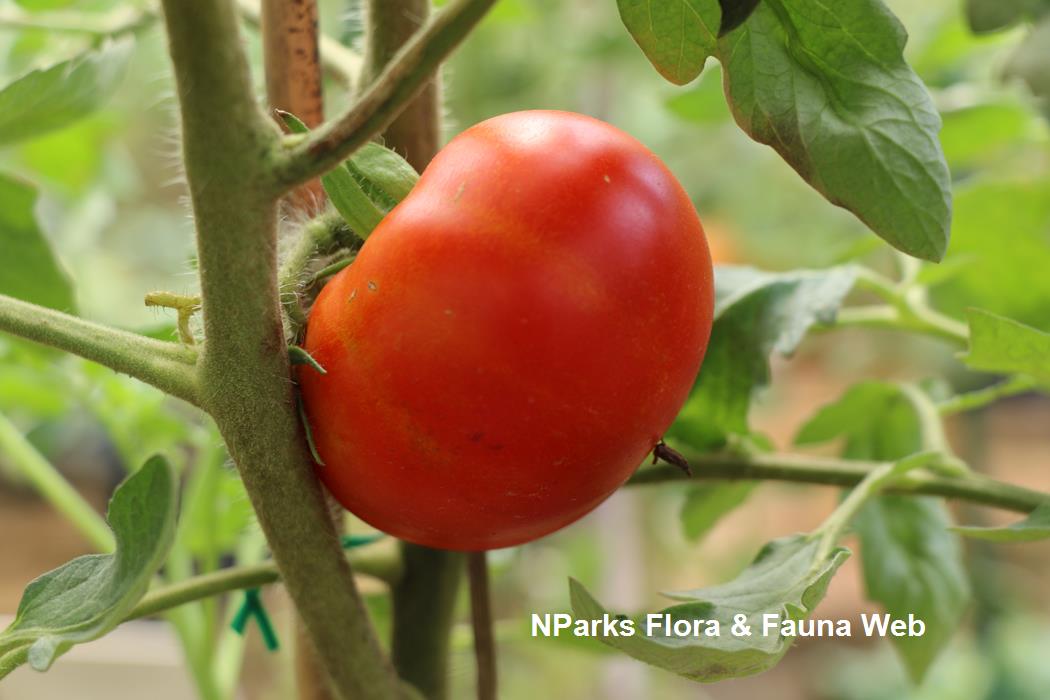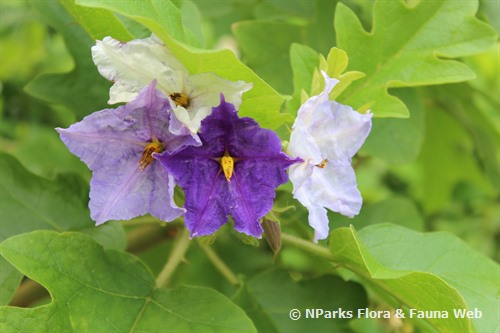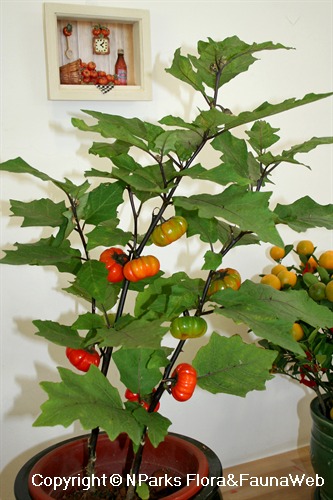
Back
Solanum torvum Sw.
| Family Name: | Solanaceae |
| Common Name: | Turkey Berry, Devil's Fig, Terung Pipit, 水茄 |
Name
Classifications and Characteristics
| Plant Division | Angiosperms (Flowering Seed Plants) (Dicotyledon) |
|---|---|
| Plant Growth Form | Shrub |
| Lifespan (in Singapore) | Perennial |
| Mode of Nutrition | Autotrophic |
Biogeography
| Native Distribution | Antilles |
|---|---|
| Native Habitat | Terrestrial |
Description and Ethnobotany
| Growth Form | A spreading or sprawling shrub that can grow up to 2 to 3m in height. |
|---|---|
| Foliage | The leaves are simple and ovate to elliptical in shape and is lobed. Leaf surface is pubescent. |
| Stems | The stems have slightly hooked thorns growing along its length and have a layer of hairs growing on it. The thorns are more sparse on aged growth. |
| Flowers | Flowers are white and are borne on a dense, branched corymb. The flowers are bisexual. The plant flowers throughout the year. |
| Fruit | The fruit is a globular, glabrous berry and measures about 1.0 to 1.15cm in diameter. Each fruit has about 300 to 400 flat, brownish seeds. Heavy rainfall discourages fruit set. |
| Habitat | It is common on roadsides and in disturbed soils, usually as individual plants. It is found up to an altitude of 1600m and prefers moist conditions. |
| Cultivation | It is ideally grown under full sun or partial shade. |
| Ethnobotanical Uses | Food (Fruit or Vegetable): Young, immature fruits are eaten raw, cooked as a vegetable or used as an ingredient in curry sauce. In Indonesia, Solanum torvum is considered as one of the best side dishes to go along with rice. Medicinal: In Malaysia the roots are used as a poultice for cracks in the feet and the seeds are smoked for curing toothache. In China, the roots are believed to disperse blood which have leaked into the surrounding tissue and to relieve pain. In India, extracts of the plant are used as an antidote to insect stings and the fruit eaten to relieve stomach ache. |
Landscaping Features
| Landscape Uses | Parks & Gardens, Small Gardens |
|---|---|
| Thematic Landscaping | Economic Garden |
Plant Care and Propagation
| Light Preference | Full Sun, Semi-Shade |
|---|---|
| Water Preference | Moderate Water |
| Rootzone Tolerance | Well-Drained Soils, Fertile Loamy Soils |
| Propagation Method | Seed, Stem Cutting |
Image Repository
Others
| Master ID | 31418 |
|---|---|
| Species ID | 5815 |
| Flora Disclaimer | The information in this website has been compiled from reliable sources, such as reference works on medicinal plants. It is not a substitute for medical advice or treatment and NParks does not purport to provide any medical advice. Readers should always consult his/her physician before using or consuming a plant for medicinal purposes. |







